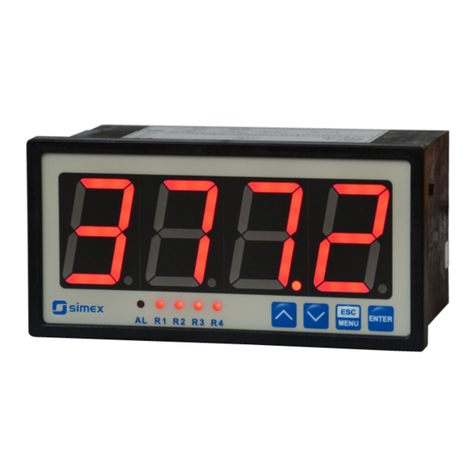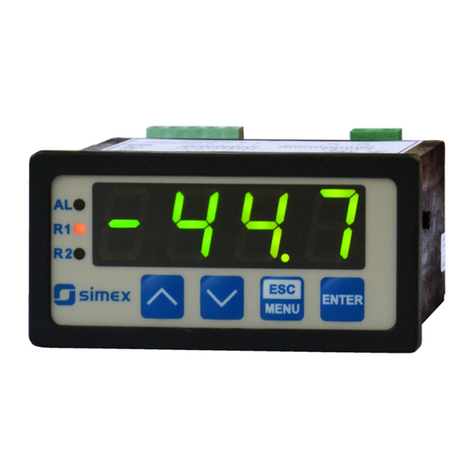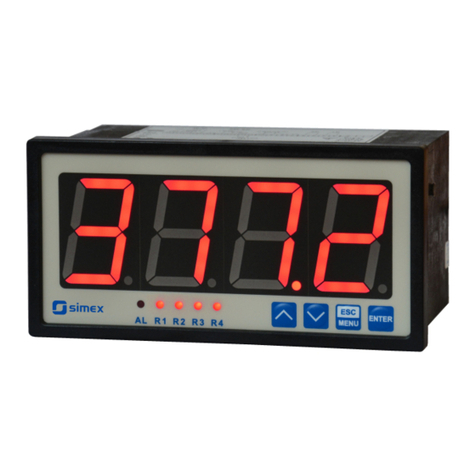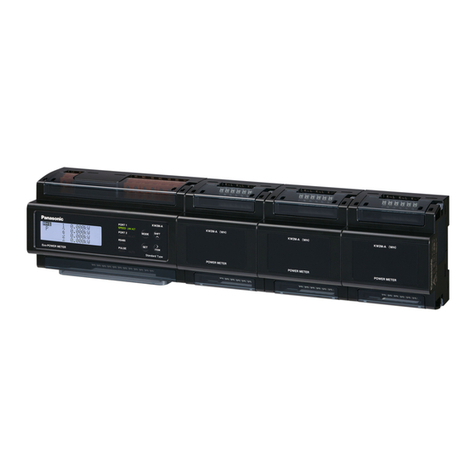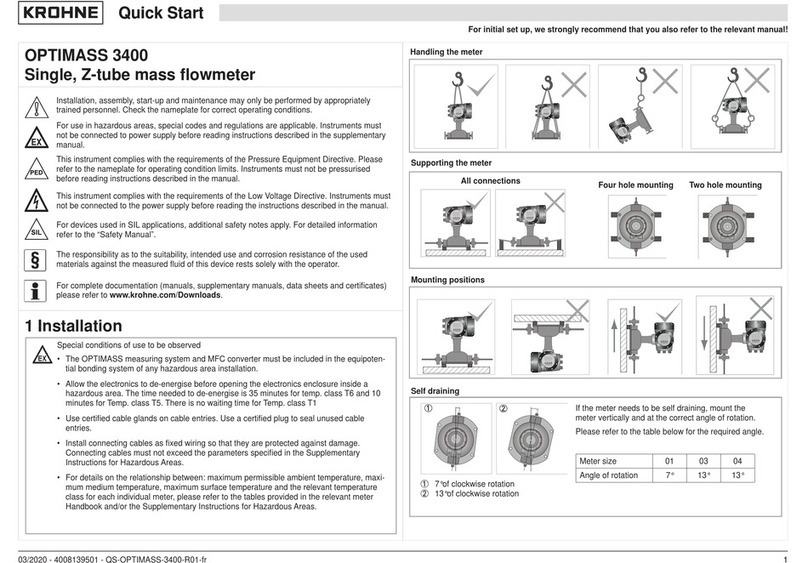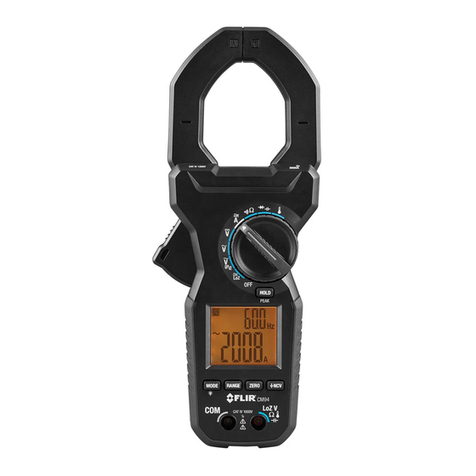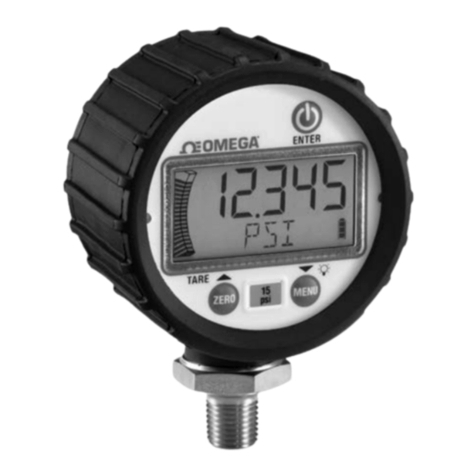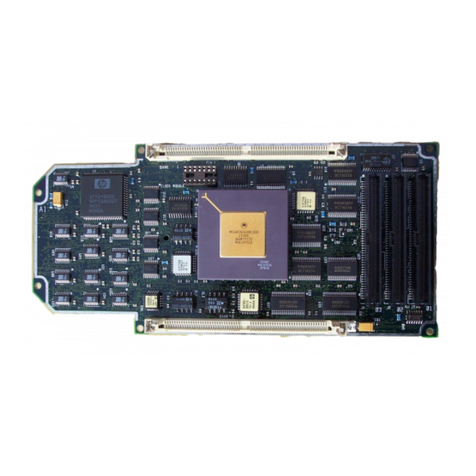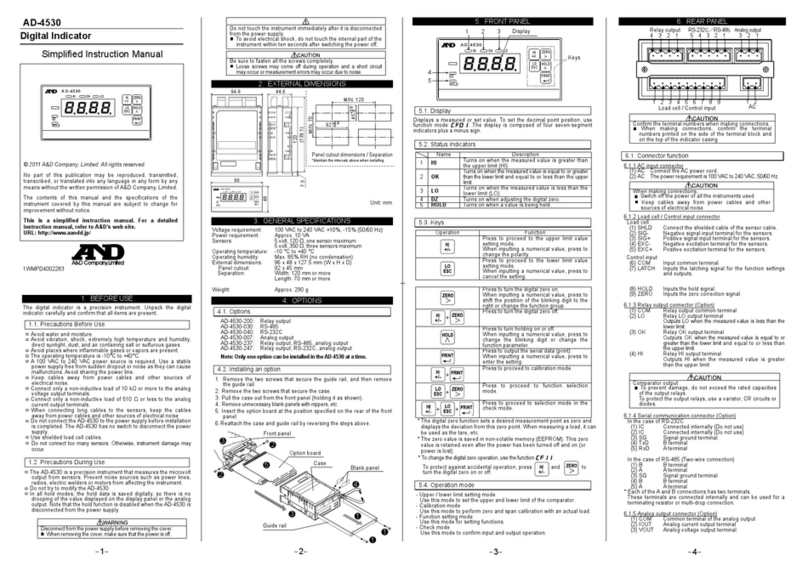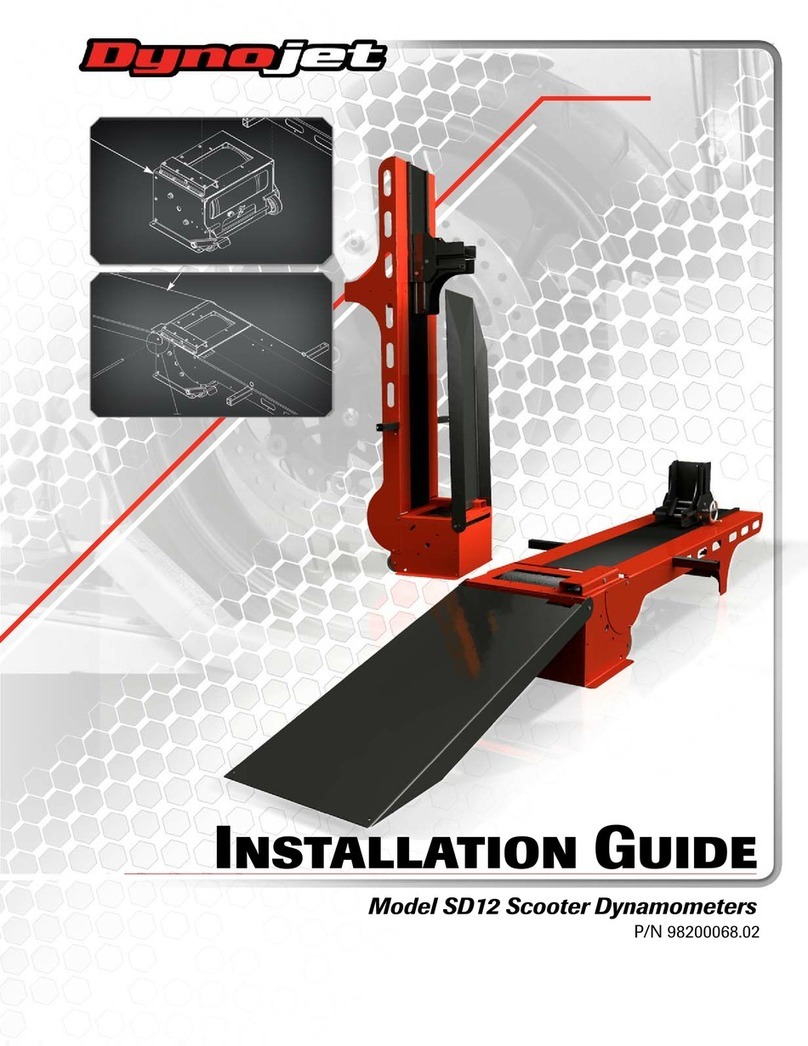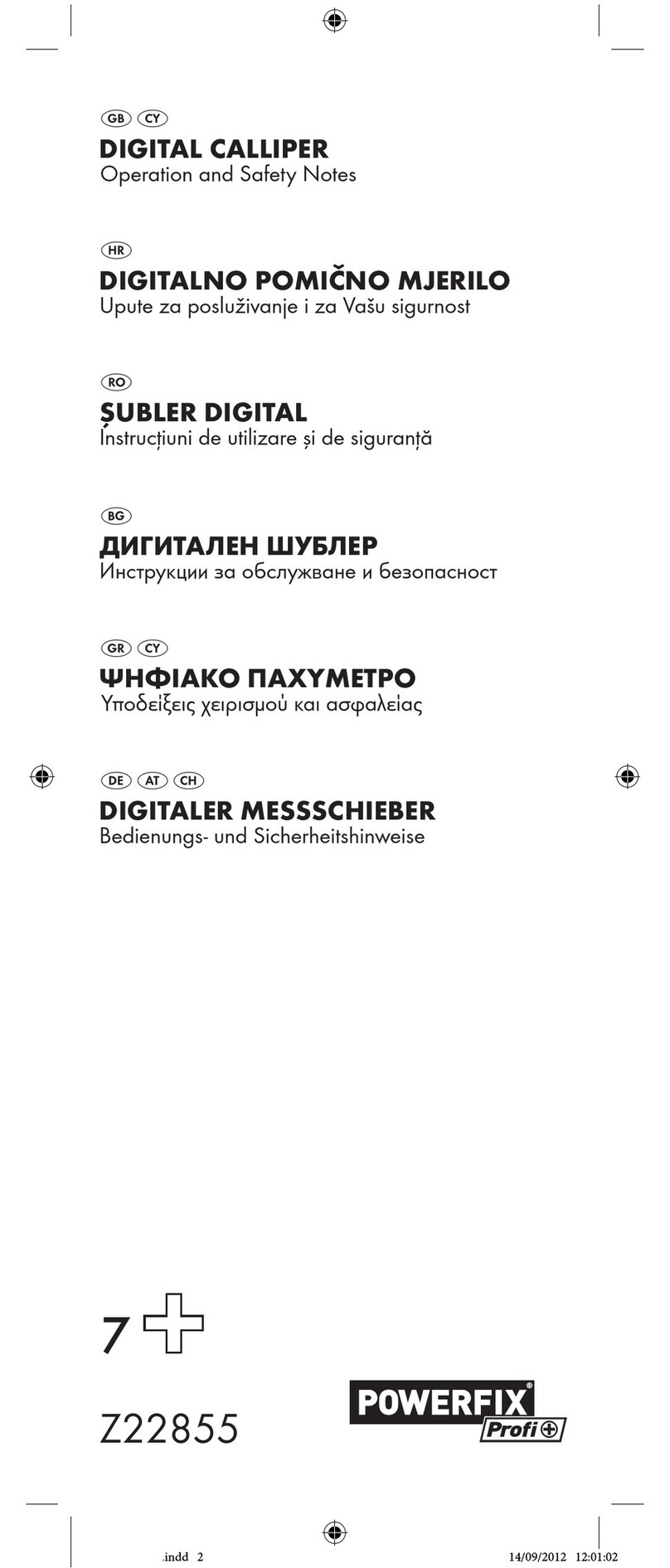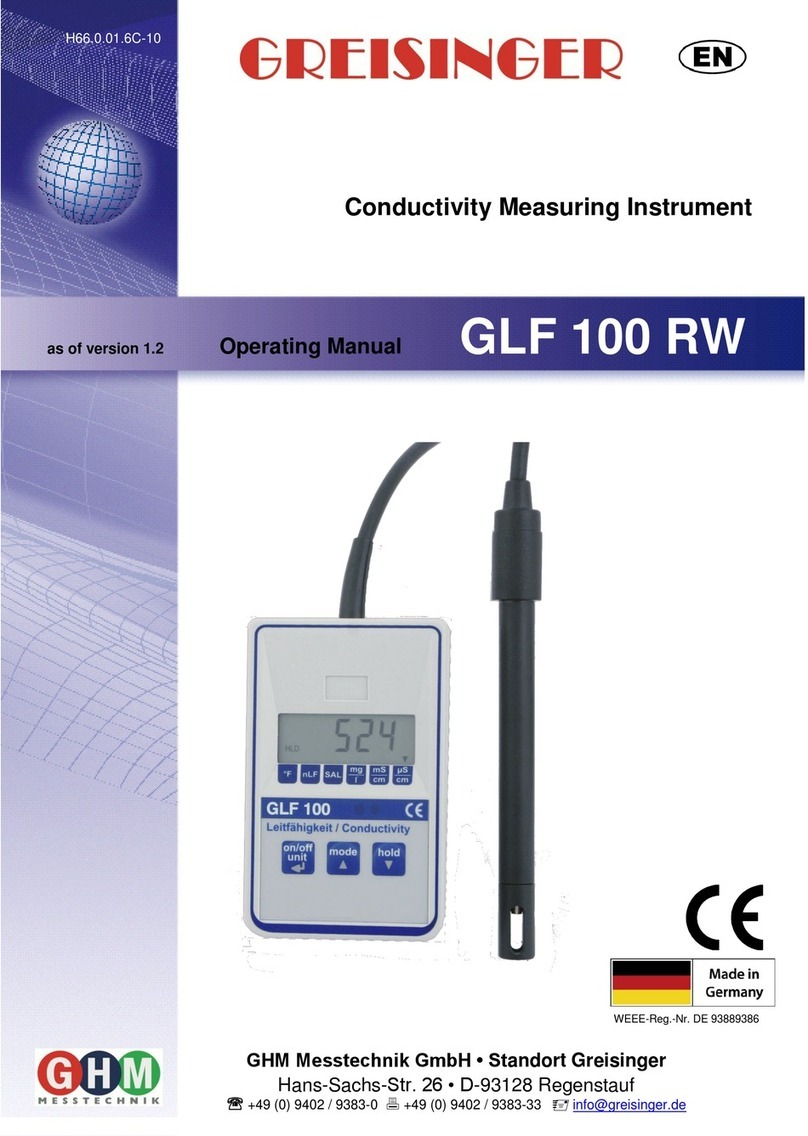Simex SRL-49 User manual

Assisting the automation
industry since 1986
User manual
METER
SRL-49
•Firmware: v.5.21 or higher
•Input type: 0/4-20 mA, 0/1-5V, 0/2-10V
•Mu tico our bargraph
Read the user's manual carefully before starting to use the unit or software.
Producer reserves the right to implement changes without prior notice.
2013.0 .03 SRL-49_INSSXEN_v.2.08.001

User manual - METER SRL-49
CONTENTS
1. BASIC REQUIREMENTS AND USER SAFETY........................................................................................3
2. GENERAL CHARACTERISTICS................................................................................................................4
3. TECHNICAL DATA......................................................................................................................................4
4. DEVICE INSTALLATION............................................................................................................................6
4.1. UNPACKING.......................................................................................................................................6
4.2. ASSEMBLY........................................................................................................................................6
4.3. CONNECTION METHOD...................................................................................................................9
4.4. MAINTENANCE................................................................................................................................15
5. FRONT PANEL DESCRIPTION................................................................................................................15
6. PRINCIPLE OF OPERATION...................................................................................................................16
6.1. MEASUREMENT MODE..................................................................................................................16
6.2. DETECTION OF THE PEAK VALUES............................................................................................17
6.3. CONTROL OF THE RELAY OUTPUTS..........................................................................................1
6.3.1. One threshold mode................................................................................................................19
6.3.2. Two thresholds mode..............................................................................................................20
7. DEVICE PROGRAMMING.........................................................................................................................21
7.1. PROGRAMMING MENU..................................................................................................................21
7.2. PARAMETERS EDITION.................................................................................................................22
7.2.1. Numeric parameters (digit change mode)...............................................................................22
7.2.2. Numeric parameters (slide change mode)..............................................................................22
7.2.3. Switch parameters (“LIST” type).............................................................................................23
7.3. MENU DESCRIPTION.....................................................................................................................23
7.3.1. “rEL1” menu.............................................................................................................................24
7.3.2. “bEEP” menu...........................................................................................................................26
7.3.3. “inPt” menu..............................................................................................................................26
7.3.4. ”OutP” menu............................................................................................................................31
7.3.5. “bAr” menu...............................................................................................................................32
7.3.6. ”bri” parameter.........................................................................................................................34
7.3.7. ”HOLd” menu...........................................................................................................................34
7.3. . ”SECu” menu...........................................................................................................................35
7.3.9. ”rS” menu.................................................................................................................................35
7.3.10. ”Edit” parameter....................................................................................................................36
7.3.11. ”dEFS” parameter..................................................................................................................36
7.3.12. ”SErv” menu..........................................................................................................................36
7.4. MENU STRUCTURE........................................................................................................................37
8. THE ALARM LED......................................................................................................................................3
. OVER-CURRENT PROTECTION.............................................................................................................3
10. DISPLAYED VALUES CALCULATION..................................................................................................3
10.1. ADDITIONAL CALCULATIONS (USED CONVERSION CHARACTERISTIC).............................39
10.1.1. Linear characteristic..............................................................................................................40
10.1.2. Square characteristic............................................................................................................40
10.1.3. Square root characteristic.....................................................................................................41
10.1.4. User defined characteristic...................................................................................................41
10.1.5. Volume characteristics of a cylindrical tank..........................................................................42
10.2. EXAMPLES OF CALCULATIONS.................................................................................................43
11. THE MODBUS PROTOCOL HANDLING...............................................................................................48
11.1. LIST OF REGISTERS....................................................................................................................4
11.2. TRANSMISSION ERRORS DESCRIPTION..................................................................................53
11.3. EXAMPLES OF QUERY/ANSWER FRAMES...............................................................................53
12. DEFAULT AND USER'S SETTINGS LIST.............................................................................................56
2

User manual - METER SRL-49
Explanation of symbols used in the manual:
- This symbol denotes especially important guidelines concerning the installation and
operation of the device. Not complying with the guidelines denoted by this symbol
may cause an accident, damage or equipment destruction.
IF THE DEVICE IS NOT USED ACCORDING TO THE MANUAL THE USER IS
RESPONSIBLE FOR POSSIBLE DAMAGES.
- This symbol denotes especially important characteristics of the unit.
Read any information regarding this symbol carefully
1. BASIC REQUIREMENTS AND USER SAFETY
- The manufacturer is not responsible for any damages caused by
inappropriate installation, not maintaining the proper environmental
conditions and using the unit contrary to its assignment.
- Installation should be conducted by qualified personnel . During installation all
available safety requirements should be considered. The fitter is responsible for
executing the installation according to this manual, local safety and EMC
regulations.
- GND input of device should be connected to PE wire;
- The unit must be properly set-up, according to the application. Incorrect
configuration can cause defective operation, which can lead to unit damage or
an accident.
- If in the case of a unit malfunction there is a risk of a serious threat to the
safety of people or property additional, independent systems and
solutions to prevent such a threat must be used.
- The unit uses dangerous voltage that can cause a lethal accident. The unit
must be switched off and disconnected from the power supply prior to
starting installation of troubleshooting (in the case of malfunction).
- Neighbouring and connected equipment must meet the appropriate standards
and regulations concerning safety and be equipped with adequate overvoltage
and interference filters.
- Do not attempt to disassemble, repair or modify the unit yourself. The unit
has no user serviceable parts. Defective units must be disconnected and
submitted for repairs at an authorized service centre.
- In order to minimize fire or electric shock hazard, the unit must be protected
against atmospheric precipitation and excessive humidity.
3
i
!
!
!

User manual - METER SRL-49
- Do not use the unit in areas threatened with excessive shocks, vibrations, dust,
humidity, corrosive gasses and oils.
- Do not use the unit in areas where there is risk of explosions.
- Do not use the unit in areas with significant temperature variations, exposure to
condensation or ice.
- Do not use the unit in areas exposed to direct sunlight.
- Make sure that the ambient temperature (e.g. inside the control box) does not
exceed the recommended values. In such cases forced cooling of the unit must
be considered (e.g. by using a ventilator).
The unit is designed for operation in an industrial environment and must
not be used in a household environment or similar.
2. GENERAL CHARACTERISTICS
The RL-49 meter is equipped with one current input 0-20 / 4-20mA and one voltage
input 0-5 / 1-5 / 0-10 / 2-10V. Current input has additionally overcurrent protection circuit,
which protects standard resistor. The selection of active input is realised by software, and
selected input can be changed at any time. Additionally the RL-49 allows user to select a
conversion characteristic of several kinds: linear, square, square root, and user defined
(max.20 points length). The measured value is displayed simultaneously on 4-digit LED
display and 20-points, colour bargraph. Set relay thresholds can be displayed on bargraph
together with the measure. Displayed values range can be selected by user, from -999 to
9999, plus decimal point.
The device can be equipped with two or four relay (or OC type) outputs. Optionally RL-
49 with two relays outputs can be equipped with active current output. Device RL-49 is
equipped with RS-485 / Modbus RTU communication interface and sensor supply output. The
meter can be ordered in two power supply versions.
RL-49 can be used for controlling and regulation of processes need proportional and
threshold control like: temperature processes (heating or cooling), valves controlling or other.
3. TECHNICAL DATA
Power supply voltage
(depending on version)
External fuse (required)
Power consumption
85...230...2 0V AC/DC; 50 ÷ 0 Hz (separated)
or 19...24...50V DC and 1 ...24...35V AC (separated)
T - type, max. 2 A
max. 4.5 VA @ 85 ÷ 2 0V AC/DC
max. 4.5 VA @ 1 V ÷ 35V AC
max. 4.5 W @ 19V ÷ 50V DC
Current input 0÷20 mA, 4÷20 mA overload protected,
maximum input current about 40 mA
Current measurement accuracy ± 0,1% @ 25°C; ± one digit (for 0÷20 mA range)
Current input resistance < 5 Ω (typical 55 Ω)
4
!
!

User manual - METER SRL-49
Voltage input 0÷5 V, 1÷5 V, 0÷10 V, 2÷10 V
Voltage measurement accuracy ± 0,1% @ 25°C; ± one digit (for 0÷10 V range)
Voltage input resistance > 50 kΩ
Temperature stability 50 ppm / °C
Display range -999 ÷ 9999, plus decimal point
Accepted prolonged input overload: 20%
Outputs
relay:
or OC-type:
sensor power supply:
active current:
0, 2 or 4 NO, 1A/250V AC (cos ϕ = 1)
0, 2 or 4; 30mA / 30VDC / 100mW
24V +5%, -10% / max. 100 mA, stabilized
range max. 0 ÷ 24 mA, load resistance max.700 Ω
(current output is optional, for two relays version only)
Communication interface RS 485, 8N1 and 8N2, Modbus RTU, not separated
Baud rate 1200 bit/s ÷ 115200 bit/s
Display LED, 4 digit, 9mm height, red and
20-points bargraph, red-green
Data memory non-volatile memory, EEPROM type
Front panel protection IP 5
optional version with panel cut-out sealing available
Terminals protection IP 20
Housing type
Housing material
Housing dimensions
Mounting hole
Assembly depth
Panel thickness
panel
NORYL - GFN2S E1
48 x 9 x 100 mm
43 x 90.5 mm
102 mm
max. 5 mm
Operating temperature
(depending on version)
0°C to +50°C
or -20°C to +50°C
Storage temperature
(depending on version)
-10°C to +70°C
or -20°C to +70°C
Humidity
Altitude
5 to 90% no condensation
up to 2000 meters above sea level
Screws tightening max. torque 0,5 Nm
Max. connection leads diameter 2,5 mm2
Safety requirements according to: PN-EN 1010-1
installation category: II
pollution degree: 2
voltage in relation to ground: 300V AC
5

User manual - METER SRL-49
insulation resistance: >20MΩ
insulation strength between power supply and
input/output terminal: 1min. @ 2300V
insulation strength between relays terminal:
1min. @ 1350V
EMC according to: PN-EN 132 -1
This is a class A unit. In a residential or a similar area it can cause radio
frequency interference. In such cases the user can be requested to use
appropriate preventive measures.
4. DEVICE INSTALLATION
The unit has been designed and manufactured in a way assuring a high level of user
safety and resistance to interference occurring in a typical industrial environment. In order to
take full advantage of these characteristics installation of the unit must be conducted correctly
and according to the local regulations.
- Read the basic safety requirements on page 3 prior to starting the installation.
- Ensure that the power supply network voltage corresponds to the nominal
voltage stated on the unit’s identification label.
- The load must correspond to the requirements listed in the technical data.
- All installation works must be conducted with a disconnected power supply.
- Protecting the power supply connections against unauthorized persons must be
taken into consideration.
4.1. UNPACKING
After removing the unit from the protective packaging, check for transportation damage. Any
transportation damage must be immediately reported to the carrier. Also, write down the unit
serial number located on the housing and report the damage to the manufacturer.
Attached with the unit please find:
- user’s manual,
- warranty,
- assembly brackets - 2 pieces.
4.2. ASSEMBLY
- The unit is designed for mounting inside housings (control panel, switchboard)
insuring appropriate protection against surges and interference. Metal housings
must be connected to ground in a way that complies with the governing
regulations.
- Disconnect the power supply prior to starting assembly.
6
!
!
!

User manual - METER SRL-49
- Check the connections are wired correctly prior to switching the unit on.
In order to install the unit, a 43 x 90.5 mm mounting hole (Figure 4.1) must be
prepared. The thickness of the material of which the panel is made must not exceed
5mm. When preparing the mounting hole take the grooves for catches located on
both sides of the housing into consideration (Figure 4.1). Place the unit in the
mounting hole inserting it from the front side of the panel, and then fix it using the
brackets (Figure 4.2). The minimum distances between the centre points of multiple
units - due to the thermal and mechanical conditions of operation - are 7 mm x
115 mm (Figure 4.3).
a)
7
!
!
43 mm
8 mm
13 mm
8 mm
13 mm
90,5 mm
1 mm
1 mm
max. 5 mm

User manual - METER SRL-49
Figure 4.3. Minimum distances when assembly of a number of units.
4.3. CONNECTION METHOD
Caution
- Installation should be conducted by qualified personnel . During installation all
available safety requirements should be considered. The fitter is responsible for
executing the installation according to this manual, local safety and EMC
regulations.
- The unit is not equipped with an internal fuse or power supply circuit breaker.
Because of this an external time-delay cut-out fuse with a small nominal current
value must be used (recommended bipolar, max. 2A) and a power supply circuit-
breaker located near the unit. In the case of using a monopolar fuse it must be
mounted on the phase cable (L).
- The power supply network cable diameter must be selected in such a way that in
the case of a short circuit of the cable from the side of the unit the cable shall be
protected against destruction with an electrical installation fuse.
- Wiring must meet appropriate standards and local regulations and laws.
- In order to secure against accidental short circuit the connection cables must be
terminated with appropriate insulated cable tips.
9
!
115 mm
7 mm

User manual - METER SRL-49
- Tighten the clamping screws. The recommended tightening torque is 0.5 Nm.
Loose screws can cause fire or defective operation. Over tightening can lead to
damaging the connections inside the units and breaking the thread.
- In the case of the unit being fitted with separable clamps they should be inserted
into appropriate connectors in the unit, even if they are not used for any
connections.
- Unused terminals (marked as n.c.) must not be used for connecting any
connecting cables (e.g. as bridges), because this can cause damage to the
equipment or electric shock.
- If the unit is equipped with housing, covers and sealing to, protecting against
water intrusion, pay special attention to their correct tightening or clamping. In the
case of any doubt consider using additional preventive measures (covers, roofing,
seals, etc.). Carelessly executed assembly can increase the risk of electric shock.
- After the installation is completed do not touch the unit’s connections when it is
switched on, because it carries the risk of electrical shock.
Due to possible significant interference in industrial installations appropriate measures
assuring correct operation of the unit must be applied. To avoid the unit of improper
indications keep recommendations listed below.
–Avoid running signal cables and transmission cables together with power supply cables
and cables controlling inductive loads (e.g. contactors). Such cables should cross at
a right angle.
–Contactor coils and inductive loads should be equipped with interference protection
systems, e.g. RC-type.
–Use of screened signal cables is recommended. Signal cable screens should be
connected to the earthing only at one of the ends of the screened cable.
–In the case of magnetically induced interference the use of twisted pair of signal cables is
recommended. Twisted pair (best if shielded) must be used with RS-485 serial
transmission connections.
–In the case of measurement or control signals are longer than 30m or go outside of the
building then additional safety circuits are required.
–In the case of interference from the power supply side the use of appropriate interference
filters is recommended. Bear in mind that the connection between the filter and the unit
should be as short as possible and the metal housing of the filter must be connected to
the earth with the largest possible surface. The cables connected to the filter output must
not be run with cables with interference (e.g. circuits controlling relays or contactors).
Connections of power supply voltage and measurement signals are executed using the
screw connections on the back of the unit’s housing.
10
!

User manual - METER SRL-49
Figure 4.4. Method of cable insulation replacing and cable terminals
All connections must be made while power supply is disconnected !
Double numeration means, that depending on device version, particular
terminal can be marked according to the top or bottom number.
Figure 4.5. Terminals description (relay outputs, no current output version)
Figure 4.6. Terminals description (relay outputs, device with current output)
11
1 2 5 6 7 8 9
GND DATA+
DATA-
R - 485
+ Uo -
+24V +5%, -10%
Imax = 100mA
10 11 12 13 14 15
R1
3 4
optional ACTIVE
current output
- +
R2
n.c. n.c. n.c.
n.c.
GND
0/1 - 5V, 0/2 - 10V
0/4-20mA
++
(optional) (optional)
Power
supply
(depending on version)
16
31
17
32
18
33
19
34
20
35
Power
supply
(depending on version)
1 2 5 6 7 8 9
GND DATA+
DATA-
R - 485
+ Uo -
+24V +5%, -10%
Imax = 100mA
10 11 12 13 14 15
R1
3 4
R2 R3
R4
(optional)
(optional)
n.c.
n.c.
GND
0/1 - 5V, 0/2 - 10V
0/4-20mA
++
(optional)
(optional)
16
31
17
32
18
33
19
34
20
35
!
-7 mm
max. 2 mm
16
31

User manual - METER SRL-49
Figure 4.7. Terminals description (OC-type outputs)
Figure 4. .Connection of 2-wire current converters
Figure 4.9. Connection of 3-wire current converters
12
1 2 5 6 7 8 9
GND DATA+
DATA-
R - 485
+ Uo -
+24V +5%, -10%
Imax = 100mA
10 11 12 13 14 15
3 4
OC1 OC2
- + + -
OC1 ÷ OC4: Umax = 30V DC,
Imax = 30mA, Pmax = 100mW
+ -
- +
OC3
OC4
(optional)
(optional)
n.c.
n.c.
GND
0/1 - 5V, 0/2 - 10V
0/4-20mA
++
(optional)
(optional)
Power
supply
(depending on version)
16
31
17
32
18
33
19
34
20
35
5 6 24V DC
- +
+ -
+
-
+
-
internally connected
16
31
17
32
18
33
19
34
20
35
16
31
17
32
18
33
19
34
20
35
+ -
5 6
-
+
+
-
24V DC
- +
internally connected
16
31
17
32
18
33
19
34
20
35
16
31
17
32
18
33
19
34
20
35

User manual - METER SRL-49
Figure 4.10. Connection of voltage converters
Depending on version:
5...230...260V AC/DC or
19...24...50V DC; 16...24...35V AC
Figure 4.11. Connection of power supply and relays
Contacts of relay outputs are not equipped with spark suppressors. While use
the relay outputs for switching of inductive loads (coils, contactors, power
relays, electromagnets, motors etc.) it is required to use additional
suppression circuit (typically capacitor 47nF/ min. 250VAC in series with
100R/5W resistor), connected in parallel to relay terminals or (better) directly
on the load. In consequence of using the suppression circuit, the level of
generated electromagnetic disturbances is lower, and the life of relay contacts
rises.
13
R4
FU E
1 2
L N
L N
10 11 12 13 14 15
3 4
FU E
R1 R2 R3
!
5 6
- +
-
+
+
24V DC
- +
-
+
+
internally connected
16
31
17
32
18
33
19
34
20
35
16
31
17
32
18
33
19
34
20
35

User manual - METER SRL-49
a) b)
Figure 4.12. Examples of suppression circuit connection:
a) to relay terminals; b) to the inductive load
Figure 4.13. Example of OC-type outputs connection
Figure 4.14. Example of current outputs connection
(for device with current output only)
14
5 6
Uo
10 11
OC1
- + + -
+
voltage input
24 V
-
Logic controller
5 6
Uo
10 11
OC1
- +
+ -
R
2k2
LED 10 mA
+
current input
4-20 mA
-
Logic controller
3 4
optional ACTIVE
current output
- +
!
N
10 11 10 11
LL
N
!

User manual - METER SRL-49
4.4. MAINTENANCE
The unit does not have any internal replaceable or adjustable components available to
the user. Pay attention to the ambient temperature in the room where the unit is operating.
Excessively high temperatures cause faster ageing of the internal components and shorten the
fault-free time of the unit's operation.
In cases where the unit gets dirty do not clean with solvents. For cleaning use warm water with
small amount of detergent or in the case of more significant contamination ethyl or isopropyl
alcohol.
Using any other agents can cause permanent damage to the housing.
Product marked with this symbol should not be placed in municipal waste. Please
check local regulations for disposal of electronic products.
5. FRONT PANEL DESCRIPTION
Symbols and functions of push-buttons:
Symbol used in the manual: [E C/MENU]
Functions:
• Enter to main menu ( press and hold by at least 2 sec.)
• Exit the current level and Enter to previous menu (or measure mode)
• Cancel the changes made in parameter being edited
Symbol used in the manual: [ENTER]
Functions :
• Start to edit the parameter
• Enter to the sub-menu,
• Confirmation of changes made in parameter being edited
15
!
MENU
E C
ENTER
MENU
E C
ENTER
AL R1 R2 R3 R4
10
20
40
0
50
60
100
30
90
80
70
display
Thresholds exceeding
LED indicators (R)
alarm LED indicator (AL)
programming
pushbuttons
bargraph

User manual - METER SRL-49
Symbol used in the manual: [^] [v]
Functions :
• Change of the present menu,
• Modification of the parameter value,
• Change of the display mode.
6. PRINCIPLE OF OPERATION
After turning the power supply on, device ID and software version are showed on the
display, next the controller goes to the measurement mode.
6.1. MEASUREMENT MODE
In the measure mode, the measurement results, converted over selected characteristic,
are displayed on the LED display. The measurement range equal to the nominal range is
called: nominal measurement range, and the measurement range equal to the extended
nominal range is called: permissible measurement range (Figure .1, .2).
Figure 6.1. Definitions of measurement ranges in mode 4 ÷ 20mA
If the result of measurement exceeds the permissible measurement range, warning ”-Hi-” or
”-Lo-” is displayed rather than input signal, depends on exceeded value (see description of
“Lo r” i “Hi r” parameters, paragraph ”inPt” menu).
Figure 6.2. Definitions of measurement ranges in mode 0 ÷ 20mA
If the measurement value do not exceeds permissible measurement range but
displayed value exceeds range -999 ÷ 9999, the warning ”-Ov-” is displayed rather
than the calculated result.
In the measurement mode user can check main thresholds values. After pressing [^] or
16
”Lo r” parameter ”Hi r” parameter
4 mA 20 mA
permissible measurement range
nominal measurement range
”Hi r” parameter
0 mA 20 mA
permissible measurement range
nominal measurement range
i

User manual - METER SRL-49
[v] button, name of the threshold (e.g. ”rEL1”) and his value will be displayed on the display
in alternating mode. If [^] or [v] will be pressed in 5 sec again, the next threshold will be
displayed, else the device comes back to the measurement mode. If a free access is enabled
(see description of ”SECu” menu), user can change the value of particular threshold pressing
button [ENTER] (see: PARAMETERS EDITION).
Input type, range of displaying values, characteristic of conversion, decimal point
position and measure filtering ratio, are user configurable parameters. All accessible
parameters can be changed by entering the menu (see: DEVICE PROGRAMMING). Use the
local keyboard or the remote controller to do it. (Note: all parameters can be remote changed
via RS-485 interface).
Configuration of the device (via menu or RS-485 interface) do not stops measures.
6.2. DETECTION OF THE PEAK VALUES
The RL-49 controller is equipped with peaks detection function. It can detect a peaks of
the input signal and display their values. Presets connected with this function are placed in
”HOLd” menu (see description of ”HOLd” menu). The detection of the peak can be done if
the measured signal raises and drops of value at least equal to parameter ”PEA”. Detected
peaks are displayed during the time defined by parameter ”timE”. If a new peak will be
detected while one is displayed, this new peak will be displayed and display time counter will
be cleared (Figure .3). If no peaks are detected while time ”timE” elapses, device starts to
show the current value of input signal again. If „Hdi ”=”HOLD” then setting parameter
"timE"=0.0 causes holding peak value until [E C] button is pressed. If „Hdi ”=”rEAL” then
value "timE"=0.0 means no holding. Displaying peak value is signalized by flashing most right
decimal point.
The relays/LEDs and the current output can be controlled depend on the current value of
input signal or the peak value (see ”HOLd” menu).
Figure 6.3. Process of peaks detection
17
”timE”
measure
time
”timE”
”PEA”
”PEA”
real measurement result
display value
i

User manual - METER SRL-49
6.3. CONTROL OF THE RELAY OUTPUTS
The control of the object (measured signal) is realized via relay outputs. Front panel
LEDs named „R” indicates the state of particular relay output.
If device is not equipped with one or more relay outputs, menus refer to this relays
are available, but apply to LED indicators only. In such case LEDs indicates
exceeding of particular thresholds.
Modes of the control can be changed depend on the values of parameters “ EtP”, “ Et2”,
“HY t”, “modE”, “t on”, “toFF”, “unit” and “AL”. Depend on “modE” parameter, relays
can be not used or controlled over one or two thresholds values.
If one threshold is used (Figure .4) the relay can be turned on (“modE” = ”on”) or off
(“modE” = ”oFF”) when the input signal value is contained in zone A. If two thresholds are
used (Figure .5) the relay will be turned on when value of input signal is contained in zone A
(“modE” = ”in”) or zone B (“modE” = ”out”) and turned off if the signal is contained in the
second one.
Figure 6.4. One threshold control of the relay/LED outputs
Figure 6.5. Two threshold control of the relay/LED outputs
The relay outputs and LEDs (named R) can be controlled depend on both - the
current value and the peak value (when peak detection is active) of the input signal.
18
zone A
zone B
measure
”SEtP” parameter
”HYSt” parameter
state of
relay/LED
zone B
zone A
zone B
measure
”SEtP” or ”SEt2” parameter
”HYSt” parameter
state of
relay/LED
i
i

User manual - METER SRL-49
6.3.1. One threshold mode
Figure . presents the principle of relay outputs operation for one threshold mode, and
an example values of other parameters.
Description:
A, B, C, D - points where measured signal exceeds border values (expected value ± allowed deviation)
BON ,BOFF ,DON ,DOFF - relays state changes moments: (for “t on” > 0, “toFF” > 0)
tA , tB , tC , tD- time periods while input signal is in zone A or zone B
Figure 6.6. Principle of LED/relay output operation for one threshold mode
Parameter “ EtP” sets a threshold of the relay, and parameter “HY t” sets a
hysteresis of the relay (Figure . a). The relay can change his state only when input value
exceeds (over or under) border value and tA ,tB ,tC ,tD times (Figure . ) are bigger than the
time defined by parameters “t on”, “toFF” and “unit”. Border values means values equal
threshold+hysteresis and threshold-hysteresis respectively.
If “t on” and “toFF” parameters are set to “0”, then the relay state will be changed
as soon as input value exceeds any of the border values (see points A and C, Figure . a,
b, c).
If values of “t on” or/and “toFF” are positive, then relay state will be turned on if the
input value exceeds the border values and stay bigger (or lower) during at least
“t on” (see points BON, DON, Figure . a, d, e). Similarly, the relay will be turned off if time
“toFF” elapse since the input signal value exceeds any of the border values (see points
BOFF, DOFF, Figure . a, d, e).
19
“ EtP” parameter
(expected signal value)
“HY t” parameter
(allowed signal
deviation)
measured
signal
displayed value
time
time
time
AB
CD
relay state
(modE = on
t on = 0
toFF = 0)
relay state
(modE = on
t on > 0
toFF > 0)
tAtBtCtD
BON
DOFF
relay state
(modE = oFF
t on = 0
toFF = 0)
relay state
(modE = oFF
t on > 0
toFF > 0)
“toFF”
parameter
“t on”
parameter
BOFF
DON
time
time
closed
open
a)
b)
c)
d)
e)
open
closed
open
open
closed
closed
“t on”
parameter
“toFF”
parameter
zone A
zone B

User manual - METER SRL-49
If tA ,tB ,tC or tD (when input signal stay in zone A or zone B) are lower than parameters “t on”
or “toFF”, the relay will not change his state (see points A and C, Figure . a, d, e).
The state of relay output while the input value exceeds the border values (points A, B, C,
D) is described by parameter “modE”. The relay can be turned on (“modE” = ”on”), or
turned off (“modE” = ”oFF”) when input signal value is contained in zone A (Figure . a).
The parameter “AL” allow user to set the relay output behaviour in critical situations (e.
g. Input values exceeds permissible measurement range). User can select that the relays
will be turned on, turned off,or not changed in critical situations.
All parameters connected with relay outputs are described in paragraph ”rEL1” menu.
6.3.2. Two thresholds mode
Objaśnienie:
A, B, C, D, E - points where measured signal exceeds border values (expected value ± allowed deviation)
BON ,BOFF ,CON ,COFF ,EON ,EOFF - relays state changes moments: (for “t on” > 0, “toFF” > 0)
tA , tB , tC , tD , tE- time periods while input signal is in zone A or zone B
Figure 6.7. Principle of LED/relay output operation for two thresholds mode
20
EOFF “ EtP” or “ Et2”
parameter
“HY t” parameter
measure
d signal
displayed value
time
time
time
AB
C
D
relay state
(modE = in
t on = 0
toFF = 0)
relay state
(modE = in
t on > 0
toFF > 0)
tAtCtD
BON
relay state
(modE = out
t on = 0
toFF = 0)
relay state
(modE = out
t on > 0
toFF > 0)
“toFF” parameter
“t on” parameter
BOFF
EON
time
time
closed
open
a)
b)
c)
d)
e)
open
closed
open
open
closed
closed
“t on” parameter
“toFF” parameter
zone A
zone B
“HY t” parameter
zone B COFF CON
E
“t on” parameter
“toFF” parameter
tBtE
This manual suits for next models
1
Table of contents
Other Simex Measuring Instrument manuals
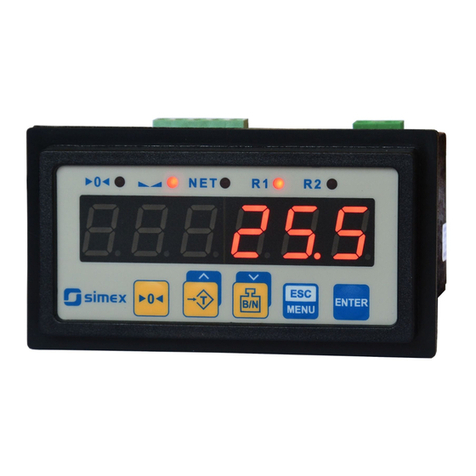
Simex
Simex SWI-94 User manual
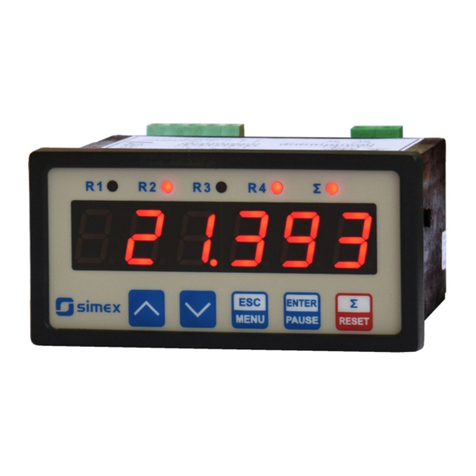
Simex
Simex SPP-94 User manual
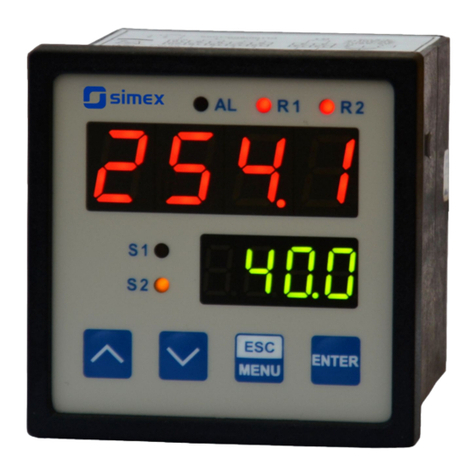
Simex
Simex SRT-77-XA User manual
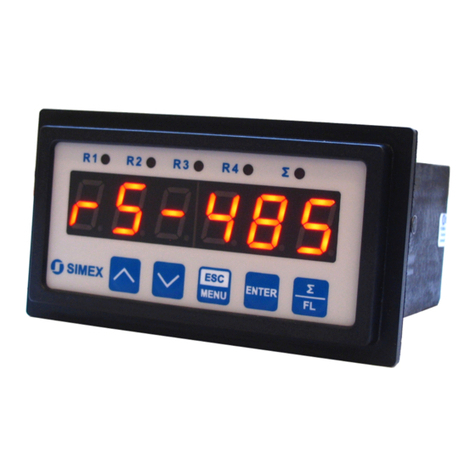
Simex
Simex SIMPACT SPI-94 User manual

Simex
Simex SRP-73 User manual
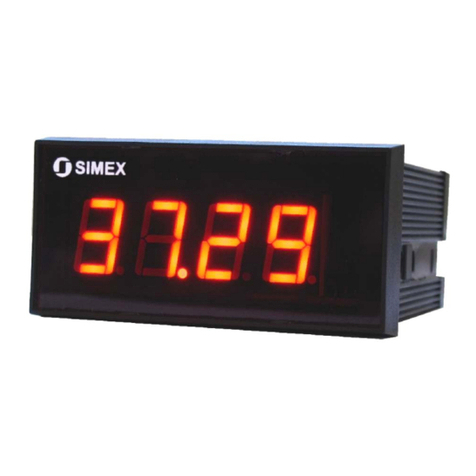
Simex
Simex SIMPACT SWE-73-A User manual
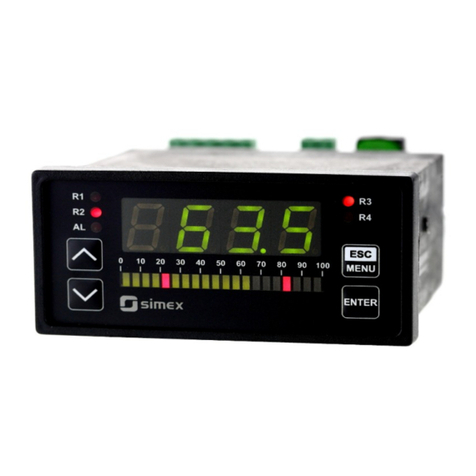
Simex
Simex SUR-94B User manual
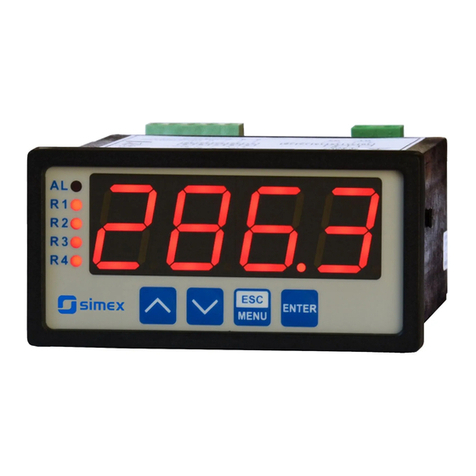
Simex
Simex SRT-94 User manual
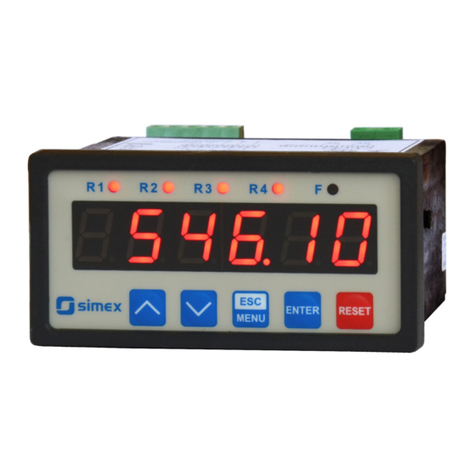
Simex
Simex SRP-946 User manual

Simex
Simex SUR-W410 User manual
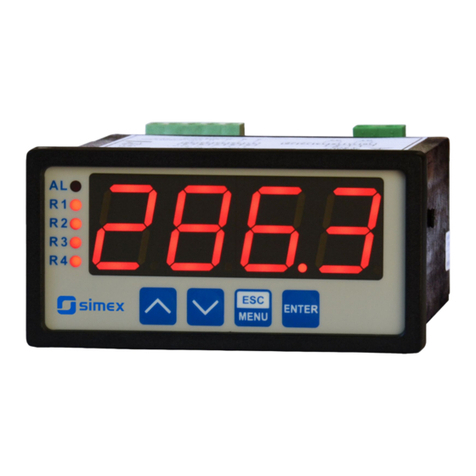
Simex
Simex SRT-94-XA User manual

Simex
Simex SRP-147-XC User manual
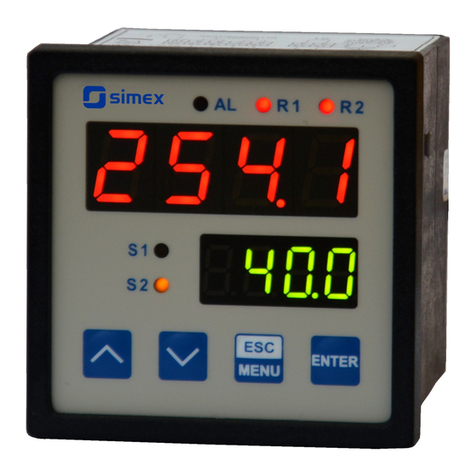
Simex
Simex Simpact SRP-77 User manual

Simex
Simex SPI-638 User manual
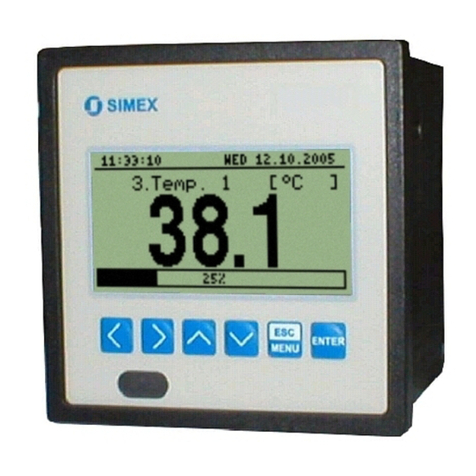
Simex
Simex SWP-99 User manual
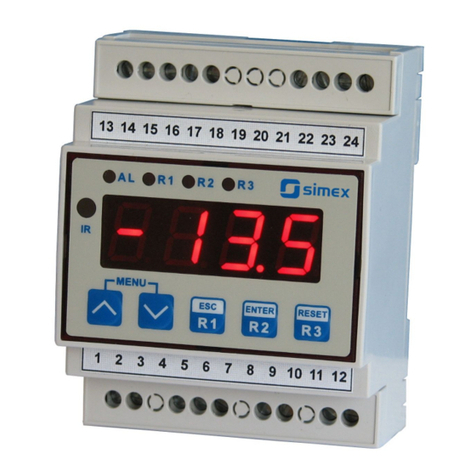
Simex
Simex SRT-L70 User manual
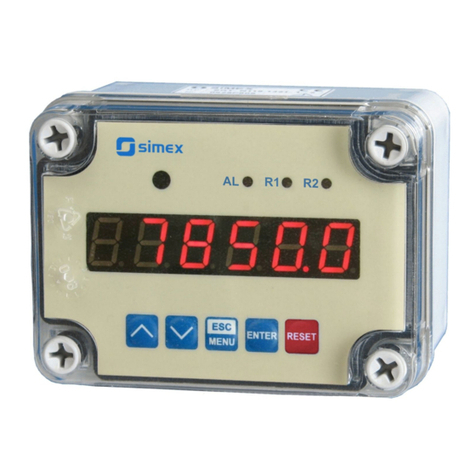
Simex
Simex STI-N118 User manual
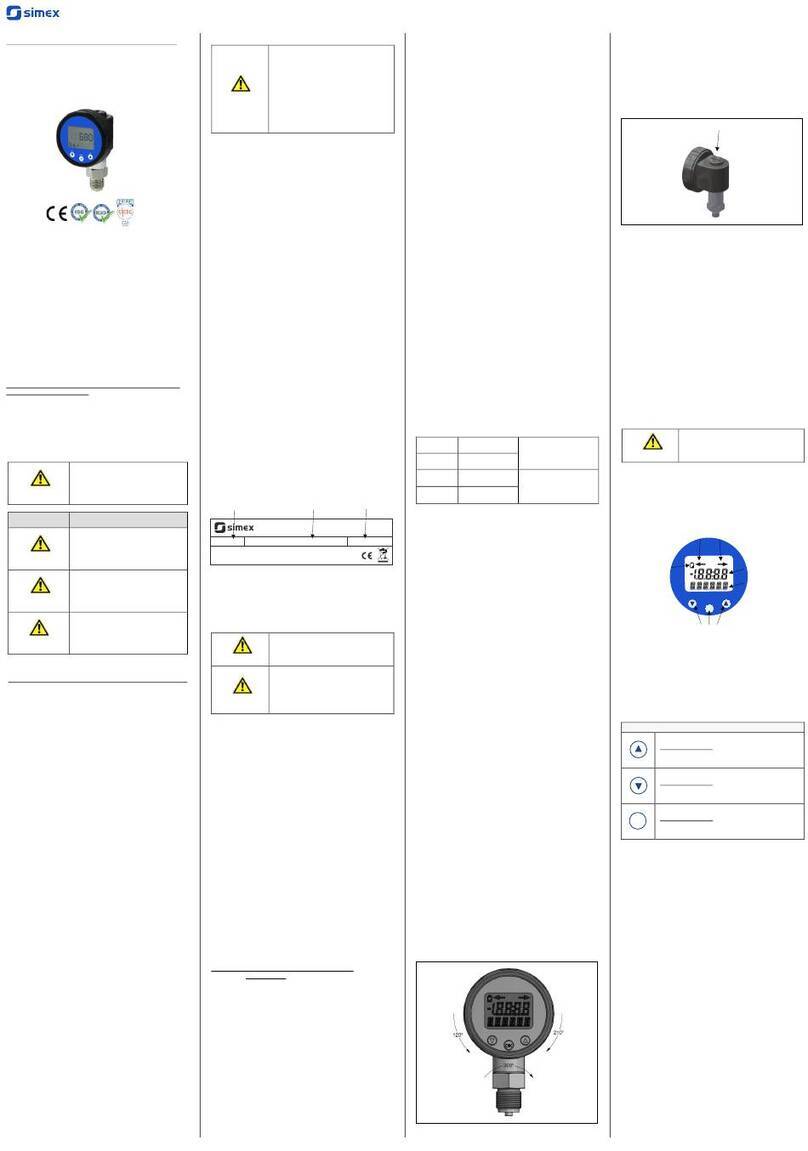
Simex
Simex CCM-P-02 User manual
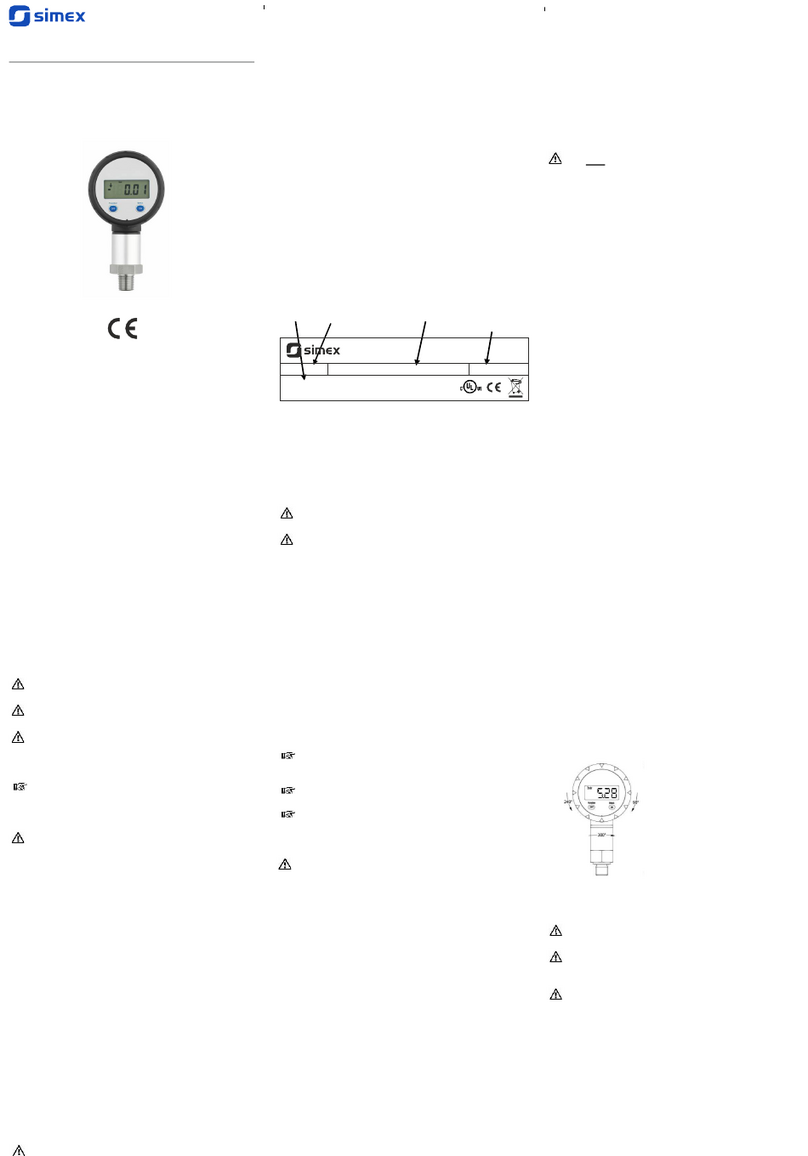
Simex
Simex CCM-K-10 User manual

Simex
Simex SRP-94-XC User manual

